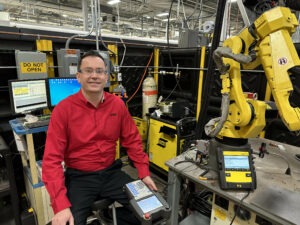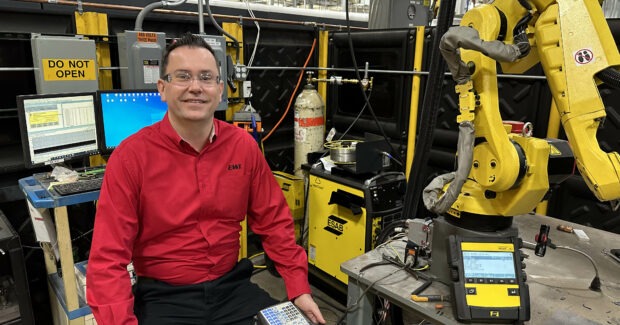ESAB Partners with EWI to Develop Innovative Solutions for Arc-DED Additive Manufacturing and Saw Processes
ESAB supplied the systems under the auspices of Future Fabricators program, developed for aspiring welders and fabricators and to promote welding innovations and new technologies.
Posted: March 25, 2024

ESAB has donated systems for robotic and submerged arc welding (SAW) to EWI® of Columbus, Ohio. To accelerate advances in arc directed energy deposition (arc DED) additive manufacturing (AM), ESAB donated an Aristo® U5000i 500A pulsing power source with a U82 control panel. This advanced gas-metal-arc waveform power supply enables development of customized synergic metal transfer “lines” for a range of emerging and new alloy applications. For SAW, ESAB donated two Aristo 1000 AC/DC 1000A inverter power sources and equipment required for the integrated cold electrode (ICE™) multi-wire process that offers very high deposition rates (up to 100lbs/hr.) at reduced heat inputs. ICE SAW solutions will benefit offshore wind and shipbuilding industries, for example, where high deposition rates and controlled heat inputs are needed to meet high strength steel property requirements while improving affordability.
ESAB supplied the systems under the auspices of Future Fabricators program, developed for aspiring welders and fabricators and to promote welding innovations and new technologies. EWI is an independent engineering consultancy with comprehensive labs and advanced manufacturing technology development capabilities that are dedicated specifically to client production process development, prototyping and solution implementation.
“ESAB and EWI have partnered for more than 15 years on projects that have elevated the level of understanding of the fundamentals and applications of materials joining,” says Ravi Menon, PhD, ESAB Filler Metals R&D. “Now we have expanded our collaboration into metal AM and digital manufacturing applications that leverage ESAB’s fusion welding and consumable technologies. ESAB’s ability to customize and formulate high-strength wires, along with EWI’s capability of producing 3D-printed structures, is leading to rapid prototyping of the components desired by industry. Other AM areas include stainless steel wires that can operate at very low levels of gas and slag coverage.”
“We recently collaborated on projects for the National Shipbuilding and Research Program to produce large-scale additive parts, as well as on other projects for the U.S. Department of Defense. ESAB has been highly responsive with its ability to develop and produce custom filler metal formulations for these projects. Combined with new innovative equipment and process knowledge, it has enabled us to expand our capabilities into unique alloys and alloys that are not typically welded,” says Michael Carney, Senior Engineer at EWI.
In addition to EWI member companies and clients, others with access to the ESAB systems include students performing research as part of advanced degrees in the welding engineering program at The Ohio State University, also co-located beside EWI in the Edison Joining Technology Center, Columbus, Ohio.
AM Advances
Using CAD to path software, arc DED uses filler wires and commercial welding power sources to add features onto an existing part or to create a new part. It is faster than other methods of additive manufacturing, extremely accurate, and can fabricate large-scale parts. In addition, arc DED can be implemented with less risk since it leverages decades of proven arc welding technology and standards.
“Compared to welding, arc DED application must ensure good deposit fusion, but we don’t need the deep penetration associated with welding,” says Carney. “These applications demand deposition procedures and synergic spatter-free metal transfer that provide smooth builds and edges that minimize post-process finishing”. By working with ESAB systems that have waveform development tools and hundreds of synergic lines, we can download the waveform and tailor it to a wide range of arc DED feature-material-process applications.”
ESAB’s U82 control panel enables users to choose from 259 factory-programmed synergic lines for manual steel, stainless steel, aluminum, and NiCrMo alloys and 68 lines for robotic welding. Preprogrammed synergic lines have optimized parameters for the wire type, wire diameter, shielding gas and process selected. As wire feed speed or arc length (trim) control are adjusted, all other welding and pulsing parameters automatically adjust with the changes to maintain an optimized arc condition.
In 2023, Carney visited ESAB’s filler metal and power source research facilities in Gothenburg, Sweden. “I was able to see some of the waveform development tools that aren’t readily available to normal users outside of very specific customers or research and development labs like us. I also got to see first-hand how quickly ESAB can create custom wires. It was an impressive operation.”
Jim Hansen, a project engineer in the Arc Welding and Directed Energy Deposition Processes Group at EWI, says that “In the next couple of years, I see us focusing on functionally gradient materials. We’re either putting down two different alloys in one weld puddle through the tandem wire process or manipulating the dilution rate throughout an AM part build. We can start with one-alloy-specific component features and move to something completely different at the other end or side of a metal additive part to achieve longer service. Graded AM solutions are needed in applications such as heat exchangers or chemical vessels that have extreme service conditions and may suffer from thermal fatigue, corrosion or oxidation and/or combination thereof.”
ICE Process
ESAB’s patented ICE process introduces a non-energized (“cold”), electrically insulated electrode into the molten weld pool created by a twin-wire SAW process. Because of the ability to adjust more variables, as well as create different torch configurations, the ICE process can be tailored to emphasize travel speed, deposition rate, heat input, bead profile and a combination of these variables. The ability of the Aristo 1000 to manipulate the AC wave form creates many possibilities for industry to explore.
“If customers, notably those in the shipbuilding and wind industries, want to investigate the potentials of the ESAB ICE system, they can come to EWI to initiate a project that focuses on procedure development and qualification for their application,” says Hansen. “Working with a trusted third party like EWI lowers their cost barrier to entry. EWI can help them determine if the technology is a fit for their application without making a capital investment.”





